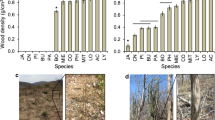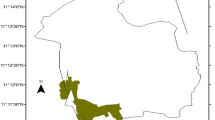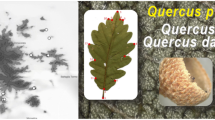Abstract
In plant taxonomy, wood density is not usually used as a classification criterion, although it could be used as a complementary measure. The aim of the present study was therefore to verify whether the xylem tissues of species belonging to the same taxon (genus or family) are similar in terms of density. In order to test this hypothesis, we examined previously reported wood basic density values for 241 tree species growing in Latin American forests and belonging to 64 genera in the families Anacardiaceae, Burseraceae, Meliaceae, Rutaceae, Sapindaceae and Simaroubaceae (order Sapindales). An estimated 57% of the species analyzed had light or very light wood (basic density < 0.65 g/cm3), although the density of the whole sample varied widely between species, from 0.24 g/cm3 for Bursera instabilis to 1.23 g/cm3 for Schinopsis brasiliensis. The lightest woods generally corresponded to species in the family Simaroubaceae and the heaviest ones to species in the family Rutaceae. The interspecific variability in basic density decreased significantly as the number of species examined in the taxon increased. Thus, species in Simaroubaceae family, the least represented in the whole sample, yielded the greatest variation in basic density between species. The findings verified that, as a single criterion, basic density is insufficient to distinguish all families and genera considered in the study, as the density did not differ significantly between Burseraceae and Meliaceae or between Sapindaceae and Rutaceae. In addition, within each family the basic density only differed significantly between four of the genera: Protium (Burseraceae), Trattinickia (Burseraceae), Zanthoxylum (Rutaceae) and Cupania (Sapindaceae).








Similar content being viewed by others
References
ABNT (2003) NBR 11941: madeira, determinaçao da densidade básica. Associaçao Brasileira de Normas Técnicas, Rio de Janeiro
Álvarez E, Benítez D, Velásquez C, Cogollo A (2013) Densidad básica del fuste del bosque seco en la costa caribe de Colombia. Revista Intertropica 8:17–28
Arévalo Fuentes RL, Londoño Arango A (2005) Manual para la identificación de maderas que se comercializan en el Departamento del Tolima. Universidad del Tolima, Ibagué
Asseflor Consultoria Agroflorestal (2018) Tabela de pesos de algumas madeiras da Amazonia. http://asseflorestal.blogspot.com.br/2012/01/tabela-de-pesos-de-alugumas-madeiras-da.html. Accessed 25 May 2018
Atencia ME (2003) Densidad de maderas (kg/m3) ordenadas por nombre común. INTI/CITEMA, Buenos Aires
Baeta I da C, Santos V (1999) Resistência dos materiais e dimensionamento de estruturas para construções rurais. Universidade Federal de Viçosa, Department Engenharia Agrícola, Viçosa
Brown S (1997) Estimating biomass and biomass change of tropical forest: a primer. FAO Forestry Paper 134. FAO, Rome
Carpio MIM (2003) Maderas de Costa Rica: 150 especies forestales, 2nd edn. Editorial Universidad de Costa Rica, San José de Costa Rica
Carvalho G (2004) Tabela de peso específico de algumas madeiras da Amazonia. AIMEX, Belém
Chave J, Muller-Landau HC, Baker TR, Easdale TA, Steege HT, Webb CO (2006) Regional and phylogenetic variation of wood density across 2456 neotropical tree species. Ecol Appl 16(6):2356–2367
Chave J, Coomes DA, Jansen S, Lewis SL, Swenson NG, Zanne AE (2009) Towards a worldwide wood economics spectrum (Global Wood Density Database). Ecol Lett 12(4):351–366
Chipaia F, Urbinati C, Dos Santos P, Reis A (2017) Identification of diagnostic anatomical features in ten species of Sapindales occurring in the Brazilian Amazon. In: 28th international conference on wood science and technology 2017. Implementation of wood science in wood working sector. European Forest Institute, Zagreb
Cronquist A (1988) The evolution and classification of flowering plants. New York Botanical Garden, Bronx
Desch HE, Dinwoodie JM (1996) Timber: structure, properties, conversion and use. MacMillan Press Ltd, Hong-Kong
FAO (2008) Evaluación de los recursos forestales nacionales 2010. Directrices para la elaboración de informes nacionales destinados a FRA 2010. Organización de las Naciones Unidas para la Alimentación y la Agricultura, Departamento de Bosques, Rome
Fearnside PM (1997) Wood density for estimating forest biomass in Brazilian Amazonia. For Ecol Manage 90(1):59–87
Forest Products Laboratory (2010) Wood handbook. Wood as an engineering material. USDA For. Serv. Gen. Tech. Rep. FPL-GTR-113, Madison
Gama RL (2018) Floral structure of Guarea macrophylla Vahl and Trichilia claussenii C.DC. (Meliaceae): funcional aspects and implications in the systematics and evolution of Sapindales. Master´s Dissertation. Instituto de Biociências, University of São Paulo, São Paulo
Ibanez T, Chave J, Barrabé L, Elodie B, Boutreux T, Trueba S, Vandrot H, Birnbaum P (2017) Community variation in wood density along a bioclimatic gradient on a hyper-diverse tropical island. J Veg Sci 28:19–33
JUNAC (1981) Tablas de propiedades físicas y mecánicas de la madera de 24 especies de Colombia. Junta del Acuerdo de Cartagena, Lima
Kraft NJB, Metz MR, Condit RS, Chave J (2010) The relationship between wood density and mortality in a global tropical forest data set. New Phytol. https://doi.org/10.1111/j.1469-8137.2010.03444.x
Li S, Lens F, Espino S, Karimi Z, Klepsch M, Jochen Schenk H, Schmitt M, Schuldt B, Jansen S (2016) Intervessel pit membrane thickness as a key determinant of embolism resistance in angiosperm xylem. IAWA J 37:152–171
Luz CL da S (2017) Phylogeny and systematics of Schinus L. (Anacardiaceae), with revision of a clade endemic to the Andean cloud forests. Doctoral Thesis. Instituto de Biociências, University of São Paulo, São Paulo
MAE-FAO (2014) Propiedades anatómicas, físicas y mecánicas de 93 especies forestales. Ministerio del Ambiente del Ecuador, Organización de las Naciones Unidas para la Alimentación y la Agricultura, Quito
Martínez-Cabrera HI, Jones CS, Espino S, Jochen Schenk J (2009) Wood anatomy and wood density in shrubs: responses to varying aridity along transcontinental transects. Am J Bot 96:1388–1398
Mettem CJ, Richens AD (1991) Hardwoods in construction. Timber Research & Development Association, High Wycombe
Missouri Botanical Garden (2018) Tropicos.org. http://www.tropicos.org. Accessed 7 Sept 2018
Mitchell JD, Douglas DC (2015) A revision of Spondias L. (Anacardiaceae) in the Neotropics. Phytokeys 55:1–92
Ogle K, Pathikonda S, Sartor K, Lichstein JW, Osnas JLD, Pacala SW (2014) A model-based meta-analysis for estimating species-specific wood density and identifying potential sources of variation. J Ecol 102:194–208. https://doi.org/10.1111/1365-2745.12178
OIMT (2018) Lesser used species. Organización Internacional de Maderas Tropicales. http://www.tropicaltimber.info/es/. Accessed 16 July 2018
Peraza Oramas C, González Álvarez MA (1973) Tecnología de la madera. Volumen I. La producción maderera y su importancia económica. AITIM, Madrid
Quintana S, Cabudivo A, Espíritu JM, Cabudivo JM (2011) Propiedades físico-mecánicas de las maderas de Simarouba amara (Aubl) y Cedrelinga catenaeformis (Ducke) de plantaciones de diferentes edades, San Juan Bautista, Loreto, Perú. Conoc Amaz 2(2):115–123
Quirino WF, Vale AT, Andrade APA, Abreu VLS, Azevedo MCS (2004) Poder calorífico da madeira e de resíduos lignocelulósicos. Biomassa e Energia 1(2):173–182
Riesco Muñoz G, Imaña Encinas J, Paula JE (2019) Densidad de la madera de 59 especies del orden Sapindales procedentes de bosques naturales brasileños. Madera y Bosques 25(2) (in press)
Rodríguez Rojas M (1996) Manual de identificación de especies forestales de la subregión andina. Instituto Nacional de Investigación Agraria-Perú, Organización Internacional de las Maderas Tropicales, Lima
Sambamurty AVSS (2010) Taxonomy of angiosperms. I.K. International Pvt. Ltd., New Delhi
Savi T, Love VL, Dal Borgo A, Martellos S, Nardini A (2017) Morpho-anatomical and physiological traits in saplings of drought-tolerant Mediterranean woody species. Trees 31:1137–1148
SFB (2014) Madeiras tropicales brasileiras, v.2. Serviço Florestal Brasileiro, LPF, Brasilia
Spicer R (2016) Variation in angiosperm wood structure and its physiological and evolutionary significance. In: Groover A, Cronk Q (eds) Comparative and evolutionary genomics of angiosperm trees. Plant genetics and genomics: crops and models, vol 21. Springer, Cham
Swenson NG, Enquist BJ (2007) Ecological and evolutionary determinants of a key plant functional trait: wood density and its community-wide variation across latitude and elevation. Am J Bot 94(3):451–459
WWF (2008) Maderas de Colombia. Global forest and trade network. World Wildlife Fund, Bogotá
WWF (2012) Maderas de Panamá. Global forest and trade network. World Wildlife Fund, Ciudad de Panamá
Zobel BJ, Buijtenen JPV (1989) Wood variation. Its causes and control. Springer, Berlin
Author information
Authors and Affiliations
Corresponding author
Ethics declarations
Conflict of interest
The authors declare that they have no conflict of interest.
Data availability
All data generated during this study are included in this published article.
Additional information
Communicated by Martina Meincken.
Publisher's Note
Springer Nature remains neutral with regard to jurisdictional claims in published maps and institutional affiliations.
José Elias de Paula: In memoriam (PhD, Prof. University of Brasilia, Botany Department, Brasilia, Brazil)
Rights and permissions
About this article
Cite this article
Riesco Muñoz, G., Imaña Encinas, J. & Elias de Paula, J. Wood density as an auxiliary classification criterion for botanical identification of 241 tree species in the order Sapindales. Eur J Forest Res 138, 583–594 (2019). https://doi.org/10.1007/s10342-019-01190-6
Received:
Revised:
Accepted:
Published:
Issue Date:
DOI: https://doi.org/10.1007/s10342-019-01190-6




